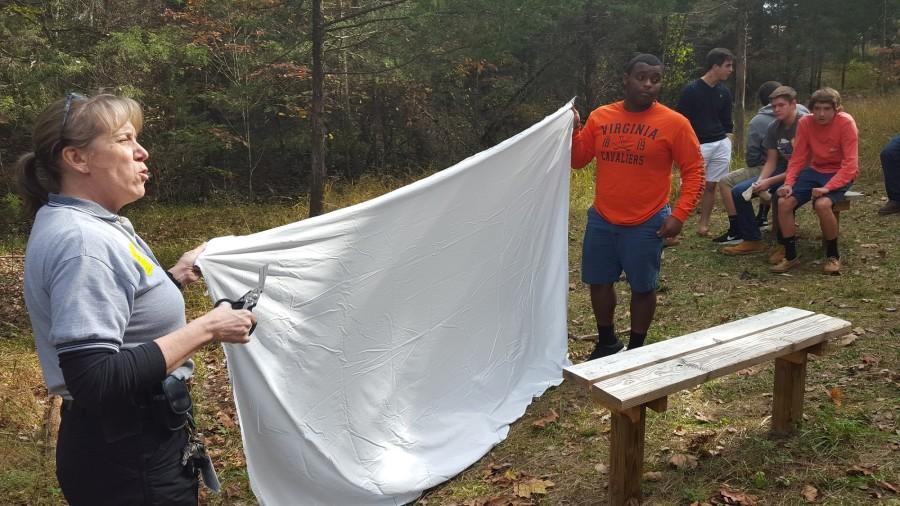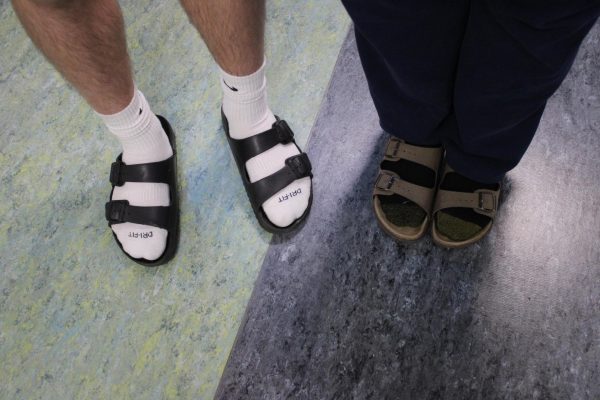Keeping Your Outdoor Adventure from Becoming a Disaster
Enjoying the great outdoors may seem like all fun and games, but what do you do when your outdoor adventure becomes a disaster? To learn to be safe outdoors, David Small’s Outdoor Adventure class brought in an expert on staying safe and handling the unexpected.
Critical care paramedic Nancy Burrows is a former fire-fighter paramedic who has conducted rescues ranging from getting people off of malfunctioning rides in amusement parks, to rescuing people from deep, dark caves. However, she said she likes to stay on dry land for her operations. “You want to know why I don’t do underwater [rescues]? It’s because of them [sharks] right there,” she told students when she visited the class in October.
Burrows showed Small’s class a detailed presentation on how to keep yourself intact during your outdoor adventure. First, Burrows stressed prevention. To prevent bad things from happening while outdoors, she said that you should know the area you will be exploring and be in your best condition to be exploring outdoors. This includes checking the weather schedule, bringing a first aid so you can get tended to immediately in case of injury, and bringing the proper equipment. “The number one reason for wilderness rescue is because of improper equipment,” Burrows said.
Burrows also said you should prepare for the most probable instances that could possibly occur. What is the terrain like? Will you need to tread carefully? Do you have a cell phone on you? Do people know you are out in the wilderness? Is there help you can get to if required? Asking these questions, she said, should give you a general idea on how to plan for possible danger.
Some of the most common injuries outdoors include falls, bites, and stings, with falls being the most common, and bites being the second most common problem, Burrows said. She explained that most falls can be prevented easily if you stay away from precarious areas and not do anything ridiculous. Falls can seriously harm you, Burrows added, and she showed several pictures to the class of fall victims’ injuries to prove her point.
According to Burrows, venomous bites and stings are the second most common obstacle in the outdoors, noting that Virginia houses both copperheads and timber rattlesnakes, both of which are venomous and can be found in Pleasant Grove or even in local backyards. As both snakes are venomous, you should be treated immediately you are bitten. Another animal Burrows said locals should look out for is the brown recluse spider. “These spiders are more afraid of you then you are of them,” Burrows said, so if you find one, leave it alone. Brown recluse bites can horribly mutilate the afflicted areas if you’re bitten, and may even require surgery. If you are bitten by a snake or spider, Burrows said it is a good idea to keep still and calm to reduce the speed of blood flow, and thereby, the speed at which the venom travels through the body before you can get treatment at a hospital.
Depending on your situation, you might need to have different items with you to be prepared for emergencies, such as Epipens for allergies, glucose tablets for diabetics, or just a bed sheet to use to make a splint or tournicate. Burrows ended her presentation by taking the class outside for a demonstration on how to use resources around for effective medical assistance. When it comes to staying safe, knowledge is the key to improvising in times of pressure.
For more information on how to prepare for outdoor emergencies, click on these links:
http://www.nps.gov/isro/planyourvisit/upload/Safety%20Tips%20for%20Hiking-2.pdf





